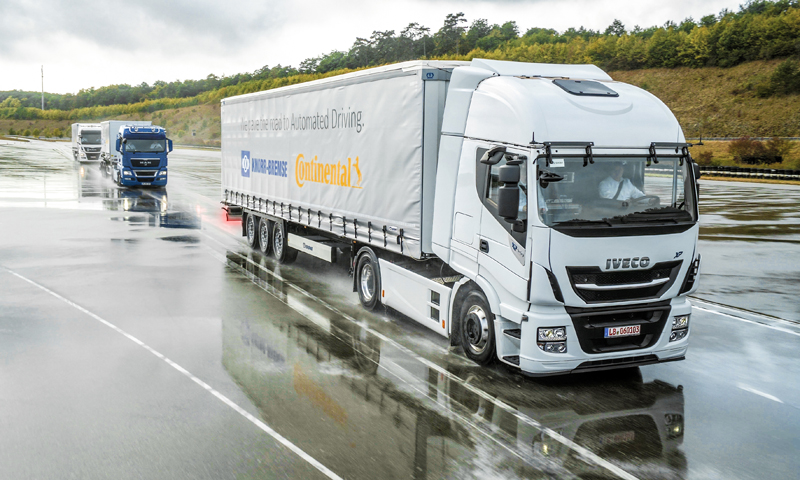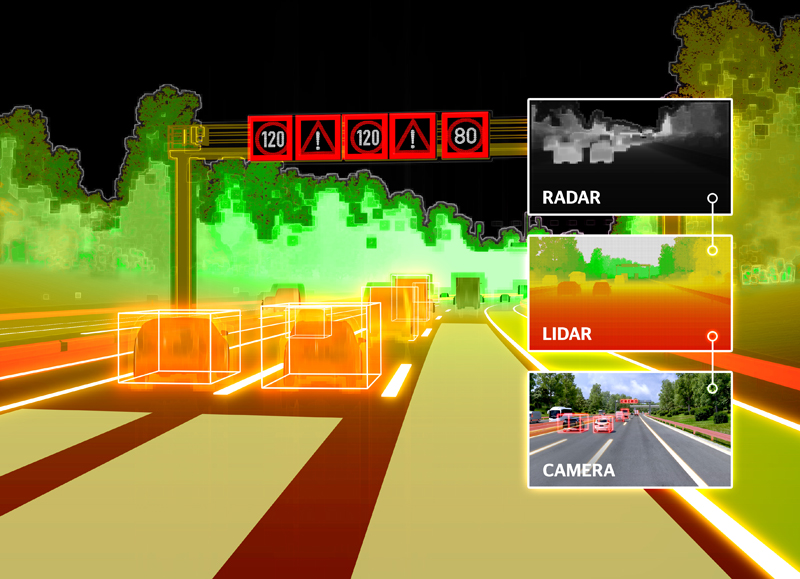Continental and Knorr-Bremse are taking a step further in its development partnership towards highly automated commercial vehicle driving: for automated platooning (i.e. driving in a column), the engineering company from Hannover and the world market leader for braking systems, and leading supplier of subsystems for rail and commercial vehicles, have joined forces to develop the Platooning Demonstrator, based on a platoon of three trucks of different makes. Initial test runs and demonstrations to customers have already been conducted at testing grounds.
The cooperation partners show with this Platooning Demonstrator what driving functions it can develop, jointly with the vehicle manufacturers, for automated driving. This includes the formation of platoons, driving together, the emergency braking function, exiting by individual vehicles and safe splitting up of the entire platoon. During the development work, special attention is being paid to the process for transferring control from the driver to the vehicle. A key element of this is clear instructions on what to do, which the driver receives via the specially designed human/machine interface. It displays the information graphically and clearly. This enables the driver to track the status of the system transparently at all times. The transfer itself is initiated on request by the push of a button as soon as the partner vehicle is less than 50 meters away. The synchronous vehicle-to-vehicle (V2V) emergency braking function ensures greater traffic safety: By initiating simultaneous braking of all the vehicles, without any delay due to reaction times, the vehicles come to a stop the same distance apart as during driving.
That now gives customers a test platform for platooning regardless of vehicle make, and a basis on which the technology can be further developed. “With the Platooning Demonstrator, we’ve reached the first milestone of our joint work. The focus now is on exchanging ideas with the vehicle manufacturers for further development of the system solution in line with the product strategies of the customers”, says Gilles Mabire, Head of the Commercial Vehicles & Aftermarket Business Unit at Continental.
“Automated driving is an evolutionary development. Our experience as a leading supplier of driver assistance products for commercial vehicles is an important foundation. Progress is continuing in the relevant technologies and our understanding of the market is improving. This is changing the conditions for automated driving and the speed at which automated driving functions are introduced. The main focuses in development thus change as well. Flexibility and openness when it comes to customer requirements and implementation routes is the key to our success. That’s why we’re keen to have close communication with our customers. It means we can present our roadmaps for products and functions, create vehicle demonstrators and react quickly to align our work with customer needs and market requirements,” adds Dr. Peter Laier, Member of the Board at Knorr-Bremse AG and responsible for its commercial vehicles division. The partners are also gearing up for further development work on automated driving on highways, the so-called Highway Pilot.
Complementary skills for a system solution
How well the skills of the two partners complement one another is shown by the technical solution of the Platooning Demonstrator. Continental is responsible for the sensors: The very latest sensor technologies are installed, including cameras and radar and lidar sensors. Together with V2V communication, the environment sensors are a central building block for safely maintaining the very short distance between vehicles during platooning. This short distance apart makes fuel-saving driving possible.
To process the sensor signals – including those with data from other vehicles (V2V) or on the traffic infrastructure (V2X) – a development environment is initially being used for the Demonstrator. To do so, the model of the respective environment too is created from the data, enabling self-orientation of the truck. In future, the system will use the central “Assisted & Automated Driving Control Unit” (ADCU) from Continental and “Global Scalable Brake Control” (GSBC) from Knorr-Bremse to supply the input for the driving strategy.
For planning the trajectory, Knorr-Bremse is contributing its expertise in the specific requirements placed on commercial vehicle dynamics. On top of that, Knorr-Bremse is implementing the requirements for driving stability (“Motion Control”) and for the actuator level, i.e. converting the driver’s decision into specific control processes inside the vehicle, and actuating steering and braking for longitudinal and lateral control.
Finally, Knorr-Bremse is also handling system integration, including validation. Commercial vehicle makers can thus rely on the experience at Knorr-Bremse, and they have a clearly defined partner to contact about automated driving topics.
Work on the Highway Pilot is beginning
The experience gained during development of the Platooning Demonstrator forms, for both Continental and Knorr-Bremse, the basis for addressing a further application for highly automated driving – the Highway Pilot. Its aim is to enable highly automated driving by single trucks on highways. A first demonstrator is planned for next year. Starting in 2020, the partners will be ready to develop this technology jointly with the manufacturers.

